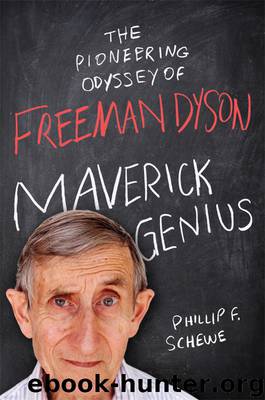Maverick Genius by Phillip F. Schewe

Author:Phillip F. Schewe
Language: eng
Format: epub, azw3
Publisher: St. Martin's Press
OUT OF THE BLACK
Much of Jason’s work was narrowly focused on military projects, things like tactical nuclear weapons and antipersonnel devices. But other problems were interesting also for their potential civilian applications. An important example was the detection or imaging of luminous objects in the sky with ground-based telescopes. The air force wanted to track enemy ballistic missiles, whereas astronomers wanted to look at distant stars. Both these activities were frustrated by the light-distorting effects of the Earth’s atmosphere. You can get a sense of this optical smearing when you look out to the horizon along an asphalt highway on a hot day. The rising heat wafts the air around just above the road, blurring the view and making mirages.
In 1972 the Pentagon sought Jason’s opinion of a proposal by a military contractor to undo the distortion with an optical system that, moment by moment, assessed the degree of overhead turbulence and quickly compensated by a selective steering or flexing of segmented reflective surfaces. This clever idea had been around since the early 1950s but had languished for want of agile enough instruments.11
By the 1970s this “active optics” scheme had become a possibility. Freeman Dyson and Steven Weinberg were grappling with the problem when into their office came a new Jason, Berkeley physicist Richard Muller, who had come up with an independent approach to the challenge of undoing the effects of turbulence. Feeling a bit intimidated by his exposure to so many senior and illustrious colleagues all at once, Muller, who later became an illustrious cosmologist himself, cautiously shared his mathematical insight with Weinberg and Dyson. Weinberg’s first reaction was that the new idea wouldn’t work. Dyson gently disagreed, and then explained how. The men grappled with the problem at the blackboard.12 It was tractable after all.
At first Jason’s labors on this topic were not under the heaviest of classification restrictions, and Dyson presented a summary in the open scientific literature.13 An active optical system, he said, would consist of the following parts:
1. A primary light-collecting mirror (the main part of every telescope), the fixed surface that captures light from the celestial object;
2. A secondary mirror with segmented parts that could be steered independently so as to subtly alter the incoming light waves in order to undo atmospheric distortions;
3. A set of little motors that could quickly reposition the segmented mirrors with great precision;
4. A digital camera recording the light signals from the object;
5. A computer able to make use of the video signal, turning it into feedback commands that actuate the adjustment motors; and
6. Software that turns the video input into the proper feedback output.
In other words, the flexible mirrors were adroitly reconfigured to counteract the bad effects of the atmosphere. The whole process struck a balance between making the sampling time too long, in which case the overhead turbulence would blur the image, or too short, in which case the intermittant arrival of straggling photons from the distant object would render a dim image.14
Dyson, designer of nuclear spaceships
Download
This site does not store any files on its server. We only index and link to content provided by other sites. Please contact the content providers to delete copyright contents if any and email us, we'll remove relevant links or contents immediately.
Hit Refresh by Satya Nadella(8854)
When Breath Becomes Air by Paul Kalanithi(8038)
The Girl Without a Voice by Casey Watson(7602)
A Court of Wings and Ruin by Sarah J. Maas(7251)
Do No Harm Stories of Life, Death and Brain Surgery by Henry Marsh(6683)
Shoe Dog by Phil Knight(4884)
Hunger by Roxane Gay(4677)
A Higher Loyalty: Truth, Lies, and Leadership by James Comey(4550)
The Rules Do Not Apply by Ariel Levy(4522)
Everything Happens for a Reason by Kate Bowler(4474)
Tuesdays with Morrie by Mitch Albom(4393)
The Immortal Life of Henrietta Lacks by Rebecca Skloot(4252)
How to Change Your Mind by Michael Pollan(4112)
Millionaire: The Philanderer, Gambler, and Duelist Who Invented Modern Finance by Janet Gleeson(4092)
All Creatures Great and Small by James Herriot(3981)
Tokyo Vice: An American Reporter on the Police Beat in Japan by Jake Adelstein(3860)
Elon Musk by Ashlee Vance(3854)
The Money Culture by Michael Lewis(3844)
Man and His Symbols by Carl Gustav Jung(3844)
